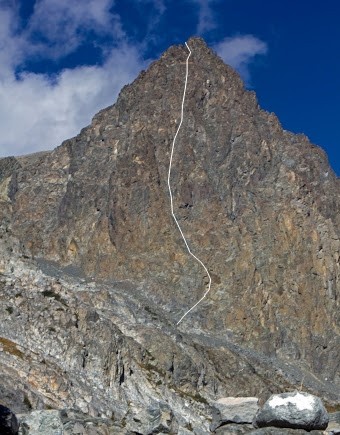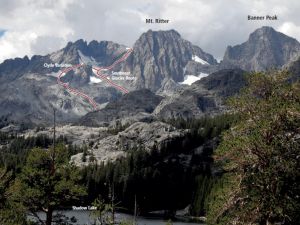Mt. Ritter and the adjacent Banner Peak are towering hulks that dominate the skyline of the Sierras between Mammoth Mountain and Tuolumne Meadows (well, if you ignore the Minarets). All of the contemporary climbing guides and websites list only three routes on Mt. Ritter: via the Ritter-Banner col, via the southeast couloir and via class 2 talus up the west side. But the 1976 edition of Steve Roper's "Climber's Guide to the High Sierra" listed another route:
"East Face. Class 4 or 5. This route lies on the west side of Ritter's
biggest face. From the lower left side of the wall, traverse up
and right on a ledge which shoots toward a prominent scar. Wander
upward above here; there are many possible routes."
My partner Jason and I decided to check it out, and it turned out to be a fabulous climb but longer and more difficult than the description implied. The start of the climb was accurately described. The "ledge" is more like a broken-up low-angle ramp, but it went at third class. The "scar" we decided was actually the brown rectangular "birth mark" that is obvious from a distance. Above that, however, the 1976 description left a bit too much to the imagination. Sticking to the easiest rock that followed a broad, shallow chute all the way up the left side of the face, the difficulty immediately increased to 5.0-5.7 for pitch after pitch. After about 10-11 pitches, the chute bumped into a wall, but a notch on the left side put us at the base of a 70-degree slab of smooth rock (much different from the blockier climbing up to that point). The slab pitch was 5.8 (5.9 according to Jason, who fortunately led it). The route again ended in a wall, and once again, the highest exit notch on the left side miraculously connected to an easy half-pitch ledge traverse to a 3rd class gully. The gully curved up and right to a beautiful skyline notch -- except that the far side dropped off in hundreds of feet of smooth vertical rock! So we tried the same trick and checked out the nearest gap in the left side of the gully, which once again offered a way onto a half-pitch ledge traverse that brought us to 3rd class gullies near the top of the southeast couloir route.
In summary: this is a great, moderate 5th class face climb on good rock with an abundance of protection and belay station options. It makes a long day (12-14 pitches total), so move quickly. There is loose rock around, but little of it fell. Be sure to know a good way through the cliff band that blocks the approach to the base of the face (at the end of the climber's trail ascending from Lake Ediza). We wound up having to rappel down it in the dark on the descent!

